DTC P2120 Throttle / Pedal Position Sensor / Switch "D" Circuit
DTC P2122 Throttle / Pedal Position Sensor / Switch "D" Circuit Low Input
DTC P2123 Throttle / Pedal Position Sensor / Switch "D" Circuit High Input
DTC P2125 Throttle / Pedal Position Sensor / Switch "E" Circuit
DTC P2127 Throttle / Pedal Position Sensor / Switch "E" Circuit Low Input
DTC P2128 Throttle / Pedal Position Sensor / Switch "E" Circuit High Input
DTC P2138 Throttle / Pedal Position Sensor / Switch "D" / "E" Voltage Correlation
Description
HINT:
- This is the repair procedure for the accelerator pedal position sensor.
- This electrical throttle system does not use a throttle cable.
- This accelerator pedal position sensor is a non-contact type.
The accelerator pedal position sensor is mounted on the accelerator pedal and detects the opening angle of the accelerator pedal. Since this sensor is electronically controlled with Hall-effect elements, accurate control and reliability can be obtained. It has 2 sensors to detect the accelerator position and a malfunction of the accelerator position sensor.
In the accelerator pedal position sensor, the voltage applied to pedal terminals VPA and VPA2 of the ECM changes between 0 V and 5 V in proportion to the opening angle of the accelerator pedal. The VPA is a signal to indicate the actual accelerator pedal opening angle which is used for the engine control, and the VPA2 is a signal to indicate the information about the opening angle which is used for detecting malfunctions. The ECM judges the current opening angle of the accelerator pedal using signals from terminals VPA and VPA2, and the ECM controls the throttle motor based on these signals.
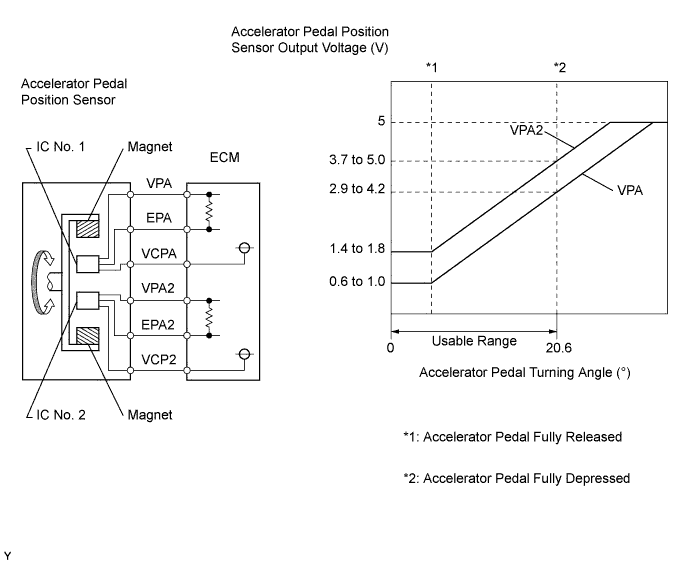
Toyota fault code list DTC P2120 DTC P2122 DTC P2123 DTC P2125 DTC P2128 DTC P2138
| DTC No. | DTC Detection Condition (All of following are 1 trip detection logic) |
Trouble Area |
| P2120 | Condition (a) continues for 0.5 sec. or more: (a) VPA is 0.4 V or less (b) VPA is 4.8 V or more |
|
| P2122 | VPA is 0.4 V or less for 0.5 sec. or more when VPA2 output indicate accelerator pedal is opened |
|
| P2123 | Condition (a) continues for 2.0 sec. or more: (a) VPA is 4.8 V or more |
|
| P2125 | Condition (a) or (b) continues for 0.5 sec. or more: (a) VPA2 is 1.2 V or less (b) VPA2 is 4.8 V or more |
|
| P2127 | VPA2 is 1.2 V or less for 0.5 sec. or more when VPA output indicates accelerator pedal is opened |
|
| P2128 | Conditions (a) and (b) continue for 2.0 sec. or more: (a) VPA2 is 4.8 V or more (b) VPA is 0.4 V or more and VPA is 3.45 V or less |
|
| P2138 | Condition (a) or (b) continues for 2.0 sec. or more: (a) Difference between VPA and VPA2 is 0.02 V or less (b) VPA is 0.4 V or less and VPA2 is 1.2 V or less |
|
HINT:
When DTC P2120, P2122, P2123, P2125, P2127, P2128, or P2138 is detected, check the output voltage of the accelerator pedal position sensor by entering the following menus on the intelligent tester: Powertrain / Engine and ECT / Data List / Accel Position 1 and Accel Position 2.
| - | Accelerator pedal position expressed as voltage output | Accelerator pedal position expressed as voltage output | Accelerator pedal position expressed as voltage output | Accelerator pedal position expressed as voltage output |
| - | Accelerator pedal released | Accelerator pedal released | Accelerator pedal depressed | Accelerator pedal depressed |
| Trouble Area | Accel Position 1 | Accel Position 2 | Accel Position 1 | Accel Position 2 |
| VCP circuit open | 0 to 0.2 V | 0 to 0.2 V | 0 to 0.2 V | 0 to 0.2 V |
| VPA circuit open or ground short | 0 to 0.2 V | 0.9 to 2.3 V | 0 to 0.2 V | 3.4 to 5.0 V |
| VPA2 circuit open or ground short | 0.5 to 1.1 V | 0 to 0.2 V | 3.0 to 4.6 V | 0 to 0.2 V |
| EP circuit open | 4.5 to 5.0 V | 4.5 to 5.0 V | 4.5 to 5.0 V | 4.5 to 5.0 V |
Wiring diagram
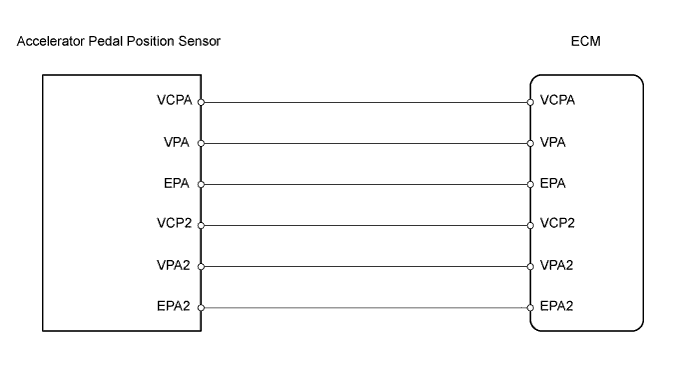
Inspection procedure
NOTICE:
After replacing the ECM, the new ECM needs registration and initialization.
| 1.READ VALUE OF ACCELERATOR PEDAL POSITION SENSOR |
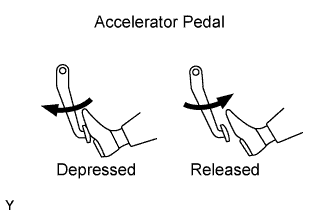
-
Connect the intelligent tester to the DLC3.
-
Turn the ignition switch on (IG) and turn the tester ON.
-
Enter the following menus: Powertrain / Engine and ECT / Data List / Accel Position 1 and Accel Position 2.
-
Read the values.
Standard voltage:
Accelerator Pedal Accel Position 1 Accel Position 2 Released 0.6 to 1.0 V 1.4 to 1.8 V Depressed 3.4 to 3.8 V 4.2 to 4.6 V
|
|
||||
| NG | |
| 2.CHECK WIRE HARNESS (ACCELERATOR PEDAL POSITION SENSOR - ECM) |
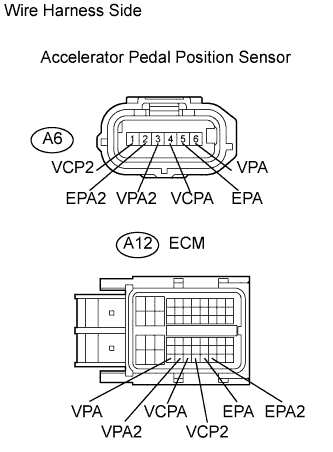
-
Disconnect the A6 accelerator pedal position sensor connector.
-
Disconnect the A12 ECM connector.
-
Measure the resistance of the wire harness side connectors.
Standard resistance:
Tester Connection Specified Condition A6-1 (VCP2) - A12-56 (VCP2) Below 1 ? A6-2 (EPA2) - A12-58 (EPA2) Below 1 ? A6-3 (VPA2) - A12-54 (VPA2) Below 1 ? A6-4 (VCPA) - A12-55 (VCPA) Below 1 ? A6-5 (EPA) - A12-57 (EPA) Below 1 ? A6-6 (VPA) - A12-53 (VPA) Below 1 ? A6-1 (VCP2) or A12-56 (VCP2) - Body ground 10 k? or higher A6-2 (EPA2) or A12-58 (EPA2) - Body ground 10 k? or higher A6-3 (VPA2) or A12-54 (VPA2) - Body ground 10 k? or higher A6-4 (VCPA) or A12-55 (VCPA) - Body ground 10 k? or higher A6-5 (EPA) or A12-57 (EPA) - Body ground 10 k? or higher A6-6 (VPA) or A12-53 (VPA) - Body ground 10 k? or higher -
Reconnect the accelerator pedal position sensor connector.
-
Reconnect the ECM connector.
|
|
||||
| OK | |
| 3.INSPECT ECM TERMINAL VOLTAGE (VCPA AND VCP2 TERMINALS) |
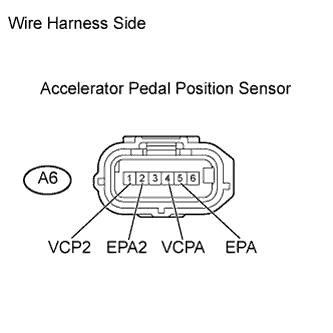
-
Disconnect the A6 accelerator pedal position sensor connector.
-
Turn the ignition switch on (IG).
-
Measure the voltage of the ECM connector.
Standard voltage:
Tester Connection Specified Condition A6-4 (VCPA) - A6-5 (EPA) 4.5 to 5.5 V A6-1 (VCP2) - A6-2 (EPA2) 4.5 to 5.5 V -
Reconnect the accelerator pedal position sensor connector.
-
Reconnect the ECM connector.
|
|
||||
| OK | |
| 4.REPLACE ACCELERATOR PEDAL ROD ASSEMBLY |
-
Replace the accelerator pedal rod assembly.
| NEXT | |
| 5.CHECK IF OUTPUT DTC RECURS |
-
Clear the DTC.
-
Start the engine.
-
Drive the engine at idle for 15 seconds or more.
-
Read the DTC.
Result:Display (DTC Output) Proceed to P2120, P2122, P2123, P2125, P2127, P2128, or P2138 is output again A P2120, P2122, P2123, P2125, P2127, P2128, or P2138 is not output B
|
|
||||
| A | |
|